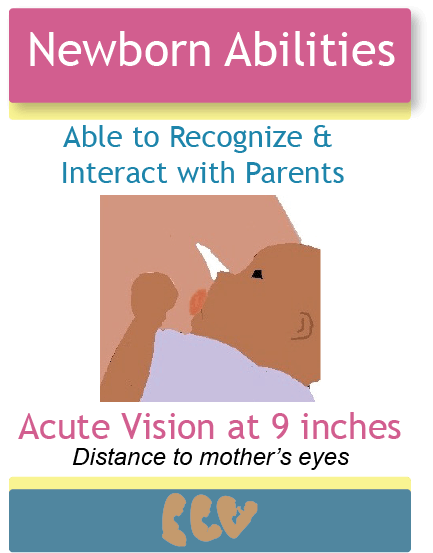
| ||
|
| ||
Newborn AbilitiesThe cognitive abilities of newborns is much greater than previously recognized. Learn some of the abilities of your newborn to see, hear, and recognize people and objects in their world.
A Wrong Assumption"Mothers were even told that their babies really couldn't see them, even though their infants were clearly looking straight into their eyes. If a parent became excited by their babies smile, they were deflated with the information that it was "merely gas." Like many scientific "facts," these assumptions that were taught when I first started in maternity care several decades ago have been proven to be utterly false. The Value of Knowing Your Baby's Personality and AbilitiesTelling a parent their infant doesn't know them, can't possibly know them, and isn't really smiling at them did significant harm. Afterall, how do you bond with someone who has no interest in the relationship. Fortunately, most parents had enough innate love to overcome the bad advice thrown at them in decades past.But we have a higher goal than merely scoffing at the mistakes of the past. When parents are taught to recongize some of the innate abilities and interactions of their newborn, they become more attuned to them. As with other behaviors that enhance bonding, this is particularly valuable if separation after birth, depression, or other factors may have not fostered the Mother/Baby Rhythm. Understanding newborn abilities isn't just good information, it's a tool that enhances the interaction between parents and child. Just What Can A Baby Do?A tool for parent-educators that summarizes these infant abilities for demonstrations with new parents was developed by Barbara Hotelling.1Some of the behaviors she documented include:
Other AbilitiesOther research supports the unique behaviors of human infants in the first few days of life:
Watch Newborns InteractWatch the ground-breaking DVD, The Amazing Talents of the Newborn with Dr. Marshal Klaus and Phyllis Klaus and produced by Johnson and Johnson. It is available on www.PennySimkin.com website.Of particular interest is the interaction where the newborn fastens her gaze on her mother's face as she sings to the baby; but then becomes confused and restless when the mother stares into space for several seconds. Mother/Infant InteractionThe two-way interaction between mothers and their babies begins before birth. The research done by Hotelling and also by Klaus and Klaus indicate that newborns recognize their fathers in the first few days of life. Rather than seeing newborns as "blank slates," parents that recognize and respond to infant's cues will increase the two way communication with the infant.References Quoted On This Page1.Hotelling, BA. Tools for teaching – newborn capabilities: parent teaching is a necessity. Jour of Perinatal Education 2004 Fall;14(4):43-49.2. Klaus, Marshall MD and Klaus, Phyllis, MFT, LMSW. Amazing Talents of the Newborn: A Guide for Healthcare Professionals and Parents (Video: 20 minutes. Johnson & Johnson. 2002. |
||
|
|
||
|
By Karen Newell Copyright 2003 - 2012 Better Childbirth Outcomes - All Rights Reserved
Camp Hill, Pennsylvania, USA | ||

